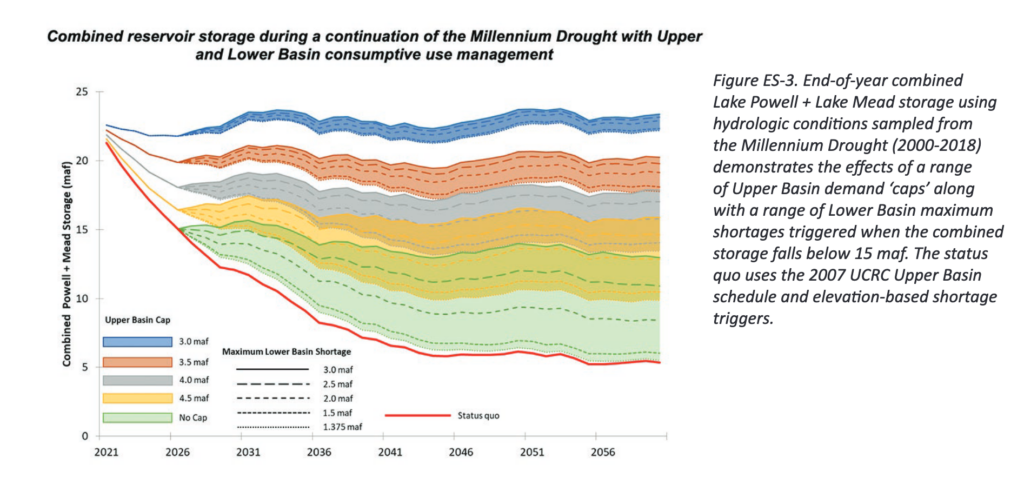 Stabilizing Colorado River reservoir levels under even moderate drought/climate change scenarios will require deeper water use reductions than basin managers have to date been willing to contemplate (at least publicly), according to a new analysis by researchers at the the Futures of the Colorado River project, based at Utah State.
Stabilizing Colorado River reservoir levels under even moderate drought/climate change scenarios will require deeper water use reductions than basin managers have to date been willing to contemplate (at least publicly), according to a new analysis by researchers at the the Futures of the Colorado River project, based at Utah State.
Led by highly respected veteran Colorado River modeler Kevin Wheeler, the team ran sophisticated new climate and river flow data through the computer modeling tools used by basin managers to try to answer basic questions about how various possible policy interventions might play out as climate change depletes the river.
Among their key findings: Under a relatively optimistic scenario (things don’t get any drier than they’ve been in the first two decades of the 21st century), stabilizing the system would require:
- The Upper Basin to not increase its uses beyond its current ~4 million acre feet per year of water use.
- The Lower Basin to adjust to routinely only getting ~6 million acre feet of water.
So how do those numbers compare to current use and policy discussions?
Recall that the Colorado River Compact “promised” each basin 7.5 million acre feet per year. The Upper Basin water users since the late 1980s have averaged about that 4 million acre foot number, but with aspirational plans to take more. The Lower Basin water users have been reducing their use from the allowable 7.5maf, using 6.9maf on average over the last five years.
So to balance things out, Upper Basin use can’t grow, Lower Basin use needs to shrink. More thank it already has.
Remember that’s the optimistic scenario. Under plausible climate change scenarios, the cuts would have to be deeper.
The results are, in some sense, unsurprising. We know that if there’s less water, people will have to use less water. And the best science, combined with the last two decades’ lived experience, suggest we’ve got less water to deal with on the Colorado River.
What’s great here is the details – a credible incorporation of the best climate science into the current Colorado River Basin policy framework, with an analysis done using CRSS, the modeling tool the management community uses to think about the Colorado River. This report, in other words, is written by a team deeply fluent in the language of Colorado River management.
The USU team has put together a nice executive summary of their findings, and the full report is here.
(Disclosure: I am an uncompensated member of the project’s advisory panel, but I didn’t play any active role in the report’s preparation beyond a lot of chit-chat with report co-author and my longtime collaborator Eric Kuhn as the work was being done.)

John,
Great summary. Reminds me of what they say about Nate Silver – it’s not just the statistics, it’s his ability to make them understandable. I agree that having an analysis done using “…the modeling tool the management community uses…” is really important.
Thanks for this update, John. It’s time that pro-development officials and others start facing reality. Growth can occur but we need to be reasonable about how it’s done. Current efforts by big money to buy up water rights to gain control and market water to the highest bidders putting more pressure on an already stressed commodity are a painful reminder of how challenging this situation is and will continue to be.
Re Lisa’s comment, if you are worried about rampant speculators buying up water rights, you might think about asking for more federal intervention in water supply development and maybe they’ll stop doing it. That is one of the factors that led to the Reclamation Act in the first place – to stop the rampant speculators and alternatively provide a stable, secure process for developing water supplies through work by the federal government in partnership with local water users associations.
Pingback: New report confronts tough choices for the future of the #ColoradoRiver: “Dire situations require solutions far from historic norms” — @AmericanRivers #COriver #aridification | Coyote Gulch
Pingback: A deep rethink of the #ColoradoRiver — The Mountain Town News #COriver #aridification | Coyote Gulch
John, thanks for your write-up on the Utah State study – pretty profound. BTW: Do you know of anyone who is looking at the likely population increases in the Colorado River Basin states over the next decade? A back-of-the-envelope calculation I did recently seems to indicate that, if the growth rates from the last decade extend for the next decade, we are looking at another 4-6 million people the Colorado will have to support. Am I missing something here?
Pingback: New report confronts tough choices for the future of the Colorado River | Hydropower Reform Coalition
Pingback: Future of the Colorado River – the “Changed River” edition | Hydropower Reform Coalition
Pingback: Future of the #ColoradoRiver – the “Changed River” edition — @AmericanRivers #COriver #aridification | Coyote Gulch
Pingback: Is This Winter’s Sketchy Snowpack the New Normal? – Miscellaneous Supply
Pingback: Is This Winter’s Sketchy Snowpack the New Normal? - Live The Good Life
Pingback: Is This Winter’s Sketchy Snowpack the New Normal? - biznewspost
Pingback: Is This Winter’s Sketchy Snowpack the New Regular? | Gadget News Plus
Pingback: Colorado River study predicts big cuts. That’s not why it’s intriguing – Water News Hub